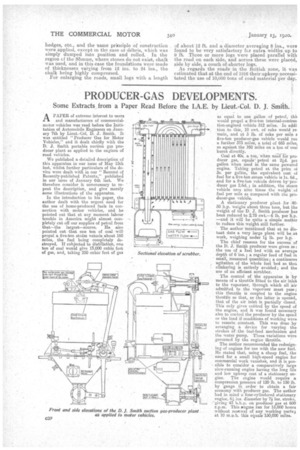PRODUCER-GAS DEVELOPMENTS.
Page 18

If you've noticed an error in this article please click here to report it so we can fix it.
Some Extracts from a Paper Read Before the I.A.E. by Lieut.-Col. D. J. Smith.
APAPER of extreme interest to users and manufacturers of commercialmotor vehicles was read before the Institution of Automobile Engineers on January 7th by Lieut.-Col, D. J. Smith. It was entitled "Producer Gas for Motor Vehicles," and it dealt chiefly with the D. J. Smith portable suction gas producer plant as applied to the engines of road vehicles.
We published a detailed description of this apparatus in our issue of May 15th last, whilst further particulars of the device were dealt with in our " Resume of Recently-published Patents," published in our issue of January 6th last. We therefore consider it, unnecessary to repeat the description, and give merely some illustrations of the apparatus.
In the introduction to his paper, the author dealt with the urgent need for the use of home-produced fuels in connection with motor vehicles, and he pointed out that at any moment labour trouble in America might almost completely cut off our supplies of petrol from that--the largest—source. He also pointed out that one ton of coal will propel a five-ton stam vehicle about 160 miles, the fuel being completely destroyed. If subjected to distillation, one ton of coal would give 13,000 cubic feet of gas, and, taking 250 cubic feet of gas
as equal to one gallon of petrol, thii would propel a five-ton internal-combus tion-engmed vehicle 312 miles. In addi tion to this, 10 cwt. of coke would re. main, and at 3 lb. of coke per mile a five-ton producer-gas vehicle would rue a further 373 miles, a total of 6E35 miles, as against the 160 miles on a ton of coal burnt directly.
Coal at 40s, a ton, when used for pro. ducer gas, equals' petrol at 24d. pet gallon when used in the same powered engine. Taking petrol at the price ol 35. per gallon, the equivalent cost • oi fuel for a five-ton steam vehicle is Is. 6d,, and for a five-ton vehicle driven by•pro. ducer gas 2.6d, ; in addition, the steam vehicle uses nine times the weight :of fuel per mile as compared with the producer-gas vehicle.
A stationary producer plant for ,4050 hp. weighs about three tons, but the weight of the D. J. Smith producer has been reduced to 2.75 cwt.-6 lb. per lip. —and it will be quite a simple matter to reduce this weight still further.
The author mentioned that at no distant date a very large plant will be at work, weighing under 1i lb. per h.p.
The chief reasons for the success of the D. J. Smith producer were given as: the use of a fuel bed with an average depth of 6 ins. ; a regular feed of fuel in small, measured quantities; a continuous agitation of the whole fuel bed so that cluakering is entirely avoided; and the use of an efficient scrubber.
The control of the apparatus is by means of a throttle fitted to the air inlet to the vaporizer, through which all .air admitted to the vaporizer must pass; this throttle is coupled to the engine throttle so that, as the latter is opened, that of the air inlet is partially closed. This only gives control by the speed of the engine, and it was found necessary also to control the producer by the speed or the load if conditions of working were to remain constant. This was done by arranging a device for varying the stiokes of the fuel-feed mechanism and the water pump. These variations were governed by the engine throttle. The author recommended the redesigning of engines for use with the new fuel. He stated that, using a cheap fuel, the need for a small high-speed engine for commercial work vanishes, and it is possible to consider a comparatively large slow-running engine having the long life and low upkeep cost of a stationary engine. The engine would •require a compression pressure of 120 lb. to 130 lb.
i by gauge n, order to obtain a fair economy with producer gas. The author had in mind a four-cylindered stationary engine, 6' ins, diameter by 74. ins. strole,
2
giving 43 b.h.n. on producer gas at 600 r.p.m. This sngme ran for 15,000 hours without rentwal of any werking parts; at 10 m.p.h. this equal's 150,000


























